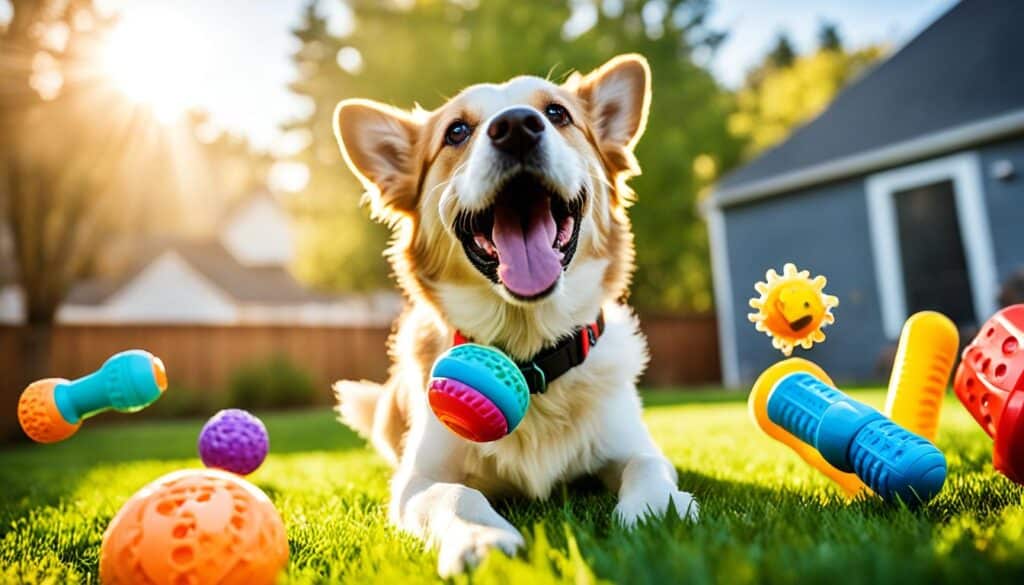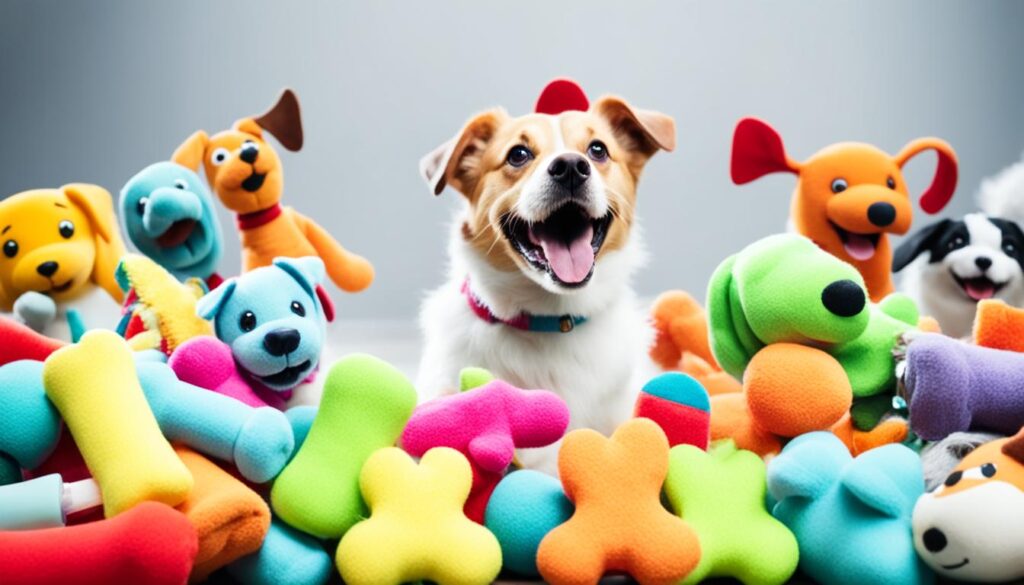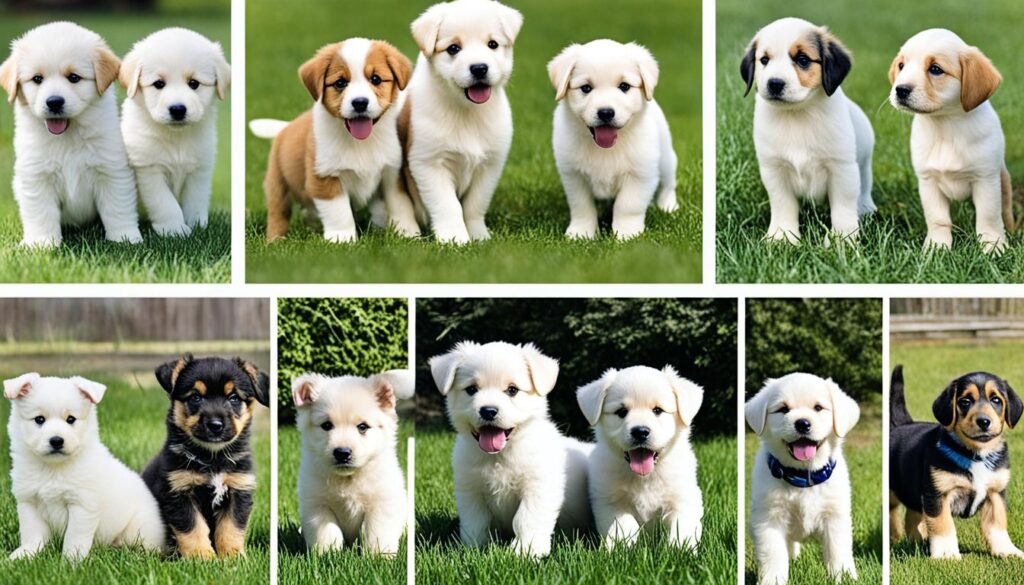Do you need help finding the right rewards to motivate and engage your dog during training? Look no further than their favorite toys! When it comes to positive reinforcement, toys can be powerful tools that not only keep your dog excited and focused but also strengthen your bond with them.
This article will explore the benefits of using toys as positive rewards in dog training. From selecting the perfect training toys to incorporating them into your training sessions, you’ll discover how to leverage the power of play to maximize your dog’s training success.

Key Takeaways:
- Toys provide high-value rewards that can motivate and engage dogs during training.
- Using toys as positive rewards strengthens the bond between you and your dog.
- Variety in training toys keeps your dog engaged and prevents boredom.
- Tug toys, fetch toys, and interactive/puzzle toys are great options for training.
- Supervise play and choose toys appropriate for your dog’s size and safety.
Why Toys Are Training Superstars
Regarding positive reinforcement training, toys are crucial in maximizing your dog’s success. They offer a unique level of excitement and engagement that can tap into your dog’s natural motivation, making training more effective for toy-driven dogs. Not only do toys provide high-value rewards, but they also bring variety to your training toolbox, keeping your dog engaged and preventing training boredom.
Motivation Matters
Some dogs are innately toy-driven, meaning they have a solid natural inclination and motivation towards play. You can tap into this motivation by using toys as high-value rewards and making training more impactful. Toys provide a level of excitement and engagement that other rewards may not achieve, making them powerful tools in positive reinforcement training.
Variety is Key
One of the benefits of using toys in training is that they offer endless possibilities for play and reinforcement. Unlike treats, which can quickly become repetitive, toys bring variety to your training sessions. This variety keeps your dog engaged and interested in the training process, adding excitement and making each session unique.
The Power of Play
Using toys in training helps reinforce desired behaviors and strengthens the bond between you and your dog. Incorporating toys into training creates positive associations between play, training, and your presence. This enhances your relationship with your dog and makes training a fun experience for both of you.
Overall, toys are training superstars. They tap into your dog’s natural motivation, offer variety to prevent training boredom and strengthen the bond between you and your furry friend. In the next section, we will explore how to select the perfect training toys that match your dog’s personality and needs.
Picking the Perfect Training Toys
Top Dog Training Toys
Explore a range of dog training toys that are effective for positive reinforcement. These toys are designed to engage dogs, promote problem-solving, and provide mental and physical stimulation during training.

Fetch Toys: The Joy of the Chase
- If your dog’s eyes light up at a bouncing ball or a flying frisbee, you have a natural fetch enthusiast! Fetch toys are fantastic for rewarding behaviors that involve movement, such as coming when called (“recall”), maintaining a stay position, or even learning tricks like “drop it.”
- Balls: Classic for a reason! Choose the right size (too small is a choking hazard). Tennis balls are popular, but for severe chewers, opt for solid rubber balls or specialized fetch toys with erratic bounces for added fun.
- Frisbees: Great for dogs who love the thrill of mid-air catches. Consider soft-fabric frisbees that are gentler on teeth or durable options for powerful chewers.
- Launchers: For dogs that need extra distance, ball launchers can take fetch to the next level. Just remember to use them safely and responsibly!
Tug Toys: Building Drive and Focus
- Tug-of-war is a fantastic way to build your dog’s focus, increase motivation, and practice impulse control. The key is to teach rules around tug, such as when to start, when to release, and how to give up the toy calmly.
- Rope Tugs: A classic choice with varying widths and thicknesses to suit different dogs. Opt for sturdy, knotted ropes.
- Fleece Tugs: These offer a softer texture, which some dogs prefer. Avoid flimsy options, and always check for fraying.
- Bungee Tugs: These add extra fun, with the stretchiness increasing the excitement factor. Great for dogs who like a dynamic tug experience.
Interactive/Puzzle Toys: Mental Muscle Matters
- Remember to underestimate the power of mental stimulation! Puzzle toys offer a fantastic way to reward calmness, independent play, and problem-solving skills.
- Treat Dispensers: Classic Kongs are a staple, but there are countless variations – wobbling dispensers, rolling treat balls, and multi-part treat puzzles.
- Snuffle Mats: These encourage natural foraging behavior. Hide treats or kibble in the nooks and crannies for your dog to sniff out.
- Advanced Puzzles: For brainy pups, look for puzzle toys with sliders, levers, or hidden compartments that require sequential problem-solving.
Toy Safety:
It’s essential to prioritize safety when selecting training toys. Always supervise play to prevent any potential ingestion or choking hazards. Choose toys appropriate for your dog’s size, ensuring they cannot swallow or choke on small parts.
Matching Toy to Personality:
Consider your dog’s energy level and problem-solving abilities when selecting training toys. High-energy dogs may benefit from durable fetch toys that provide an outlet for their energy, while clever dogs may enjoy the challenge of puzzle toys that require problem-solving skills.
How to Use Toys in Positive Reinforcement
Toys can be powerful tools in positive reinforcement training, providing high-value rewards that motivate and engage dogs. You can use toys effectively to enhance your dog’s training experience and reinforce desired behaviors. Here are some strategies for incorporating toys into positive reinforcement:
Control = Value:
By reserving playtime with toys as a unique and exclusive reward for training, you create a stronger association between positive behaviors and the joy of play. This increases the toy’s value as a reward, making it more effective in reinforcing desired behaviors.
Short and Sweet Play Sessions:
Rather than engaging in extended play sessions, incorporate short play bursts into your training sessions. This approach keeps your dog motivated and focused on the training task, preventing them from becoming overly distracted.
Build the Excitement:
To further increase your dog’s desire for the toy as a reward, engage in interactive play that mimics prey-like behavior. Playing keep-away or animating the toy can heighten your dog’s excitement and motivation, making the toy an even more enticing reward.
Fade Treats Gradually:
Pair them with a favorite treat to create a strong association when incorporating toys as rewards. Gradually decrease the reliance on treats and emphasize the joy and excitement of playing with the toy. This approach shapes your dog’s behavior through the intrinsic reward of play, fading treats in favor of toys.

By following these strategies, you can effectively use toys in positive reinforcement training. Remember to make playtime with toys exclusive to training, incorporate short and focused play sessions, build excitement through interactive play, and fade treats gradually. Harnessing the power of toys as rewards will enhance your dog’s training experience and strengthen your bond.
Additional Tips for Success
Beyond Basic Toys:
Expand your training toolbox by incorporating everyday objects and do-it-yourself puzzle toys. Not only does this provide mental and physical enrichment for your dog, but it also encourages their problem-solving skills and creativity. Using everyday household items such as cardboard boxes, you can create fun and interactive games that stimulate your dog’s mind and engage them in training. DIY puzzle toys are a cost-effective way to provide your dog with mental stimulation and help them develop their problem-solving abilities.
When Toys Aren’t Enough:
While toys can be highly effective in positive reinforcement training, it’s essential to recognize that not all dogs are solely motivated by play. Some dogs may require additional rewards, such as praise, petting, or other positive reinforcement, to maximize their training success. By understanding what motivates your dog and experimenting with different rewards, you can find the ultimate combination for them. It’s essential to tailor your training approach to meet your dog’s unique needs and preferences.
Avoiding Overexcitement:
Recognizing when toy play is tipping over into unfocused energy and causing your dog to lose focus is crucial. Overexcitement can hinder training progress and make it difficult for your dog to retain the information being taught. If you notice signs of overstimulation, such as excessive barking, jumping, or hyperactive behavior, it’s essential to redirect their energy and regain their attention. Switch to calmer rewards, such as treats or verbal praise, to help them refocus and maintain a peaceful and attentive state during training sessions.
Conclusion
In conclusion, incorporating toys into positive reinforcement training can profoundly impact your dog’s motivation, engagement, and overall training success. Using toys as high-value rewards, you tap into your dog’s natural drive and create a stronger association between positive behaviors and the joy of play. This makes training more effective and strengthens the bond between you and your furry companion.
The power of toys lies in their ability to provide variety and excitement in training sessions. Unlike treats that can quickly become repetitive, toys offer endless possibilities for play and reinforcement. You keep your dog engaged and prevent training boredom by introducing different types of toys, such as tug toys, fetch toys, and interactive puzzle toys. This keeps your dog enthusiastic and eager to participate in training exercises.
Using toys in positive reinforcement training also builds a love of play and strengthens your relationship with your dog. Incorporating toys into training sessions creates positive associations between play, training, and your presence. This makes training a fun and enjoyable experience for both you and your dog, fostering a deeper connection and sense of trust.
Selecting suitable toys for your dog is crucial. When choosing training toys, consider your dog’s personality, energy level, and problem-solving abilities. Additionally, prioritize safety by supervising play and selecting appropriate toys for your dog’s size. By maximizing the use of toys in positive reinforcement training, you can create a well-trained pup who is obedient, happy, and fulfilled.

